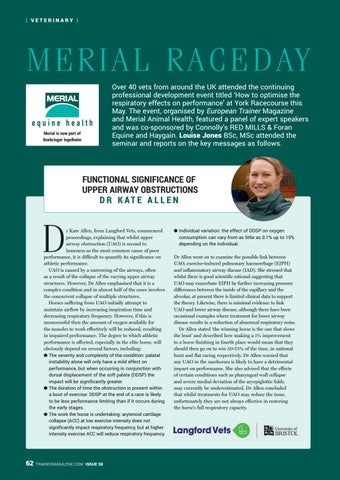| VETERINARY |
M E R I A L R A C E D AY Over 40 vets from around the UK attended the continuing professional development event titled ‘How to optimise the respiratory effects on performance’ at York Racecourse this May. The event, organised by European Trainer Magazine and Merial Animal Health, featured a panel of expert speakers and was co-sponsored by Connolly’s RED MILLS & Foran Equine and Haygain. Louise Jones BSc, MSc attended the seminar and reports on the key messages as follows.
Merial is now part of Boehringer Ingelheim
FUNCTIONAL SIGNIFICANCE OF UPPER AIRWAY OBSTRUCTIONS D R K AT E A L L E N
D
r Kate Allen, from Langford Vets, commenced proceedings, explaining that whilst upper airway obstruction (UAO) is second to lameness as the most common cause of poor performance, it is difficult to quantify its significance on athletic performance. UAO is caused by a narrowing of the airways, often as a result of the collapse of the varying upper airway structures. However, Dr Allen emphasised that it is a complex condition and in almost half of the cases involves the concurrent collapse of multiple structures. Horses suffering from UAO initially attempt to maintain airflow by increasing inspiration time and decreasing respiratory frequency. However, if this is unsuccessful then the amount of oxygen available for the muscles to work effectively will be reduced, resulting in impaired performance. The degree to which athletic performance is affected, especially in the elite horse, will obviously depend on several factors, including: ● The severity and complexity of the condition: palatal instability alone will only have a mild effect on performance, but when occurring in conjunction with dorsal displacement of the soft palate (DDSP) the impact will be significantly greater. ● The duration of time the obstruction is present within a bout of exercise: DDSP at the end of a race is likely to be less performance limiting than if it occurs during the early stages. ● The work the horse is undertaking: arytenoid cartilage collapse (ACC) at low exercise intensity does not significantly impact respiratory frequency, but at higher intensity exercise ACC will reduce respiratory frequency.
62 TRAINERMAGAZINE.COM
ISSUE 58
● Individual variation: the effect of DDSP on oxygen consumption can vary from as little as 0.1% up to 15% depending on the individual.
Dr Allen went on to examine the possible link between UAO, exercise-induced pulmonary haemorrhage (EIPH) and inflammatory airway disease (IAD). She stressed that whilst there is good scientific rational suggesting that UAO may exacerbate EIPH by further increasing pressure differences between the inside of the capillary and the alveolar, at present there is limited clinical data to support the theory. Likewise, there is minimal evidence to link UAO and lower airway disease, although there have been occasional examples where treatment for lower airway disease results in a reduction of abnormal respiratory noise. Dr Allen stated ‘the winning horse is the one that slows the least’ and described how making a 1% improvement to a horse finishing in fourth place would mean that they should then go on to win 50-75% of the time, in national hunt and flat racing respectively. Dr Allen warned that any UAO in the racehorses is likely to have a detrimental impact on performance. She also advised that the effects of certain conditions such as pharyngeal wall collapse and severe medial deviation of the aryepiglottic folds may currently be underestimated. Dr Allen concluded that whilst treatments for UAO may reduce the issue, unfortunately they are not always effective in restoring the horse’s full respiratory capacity.
